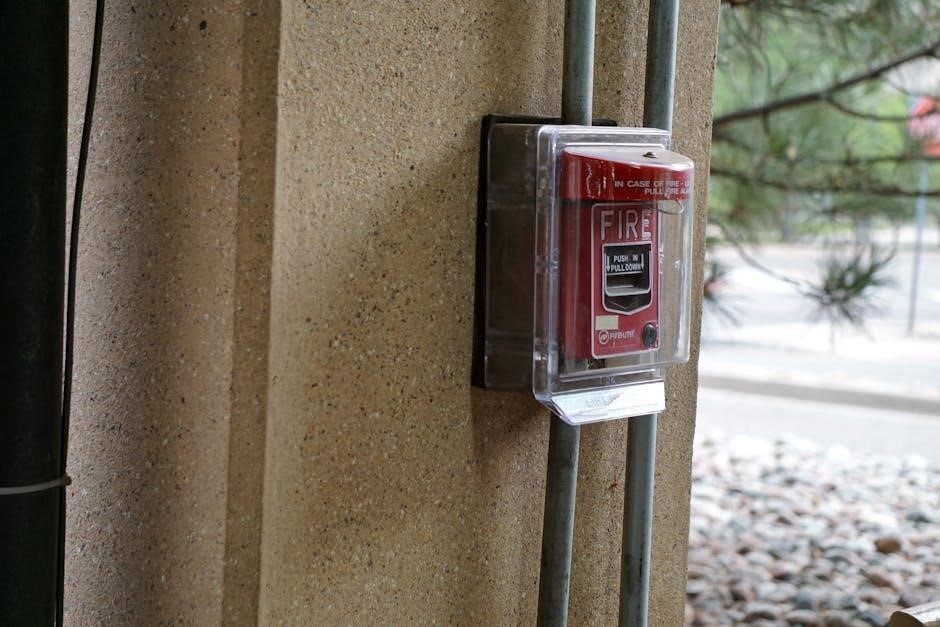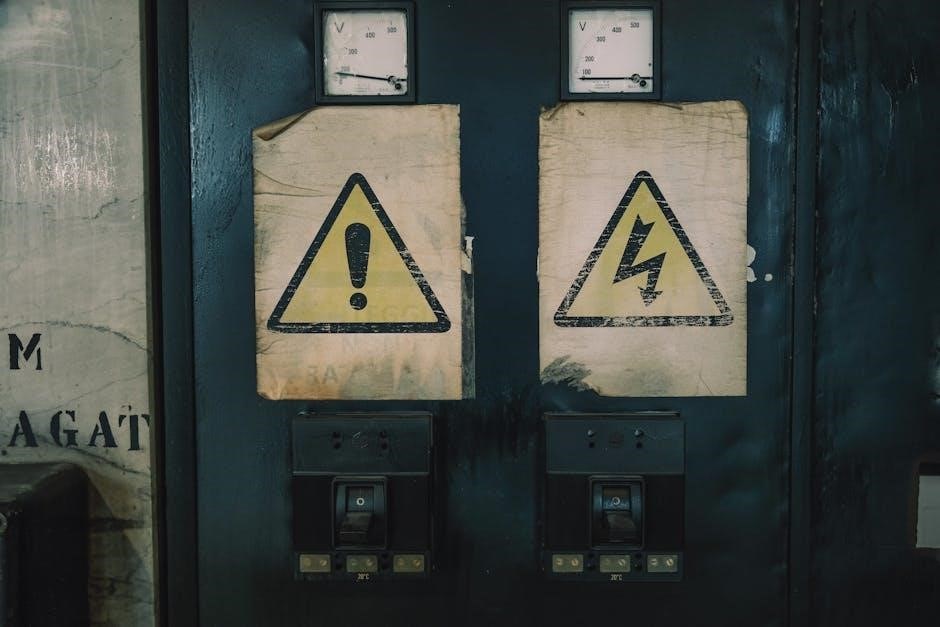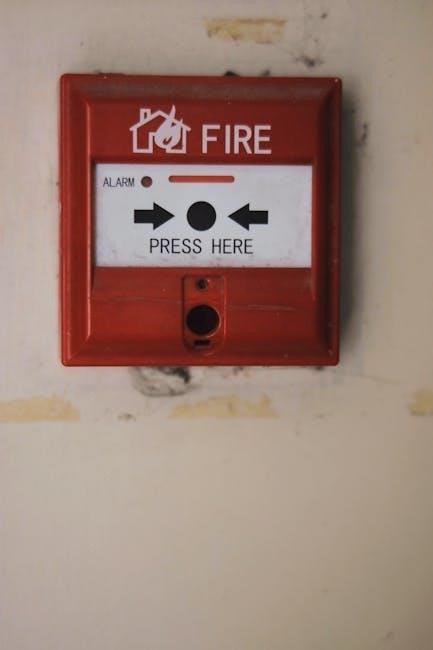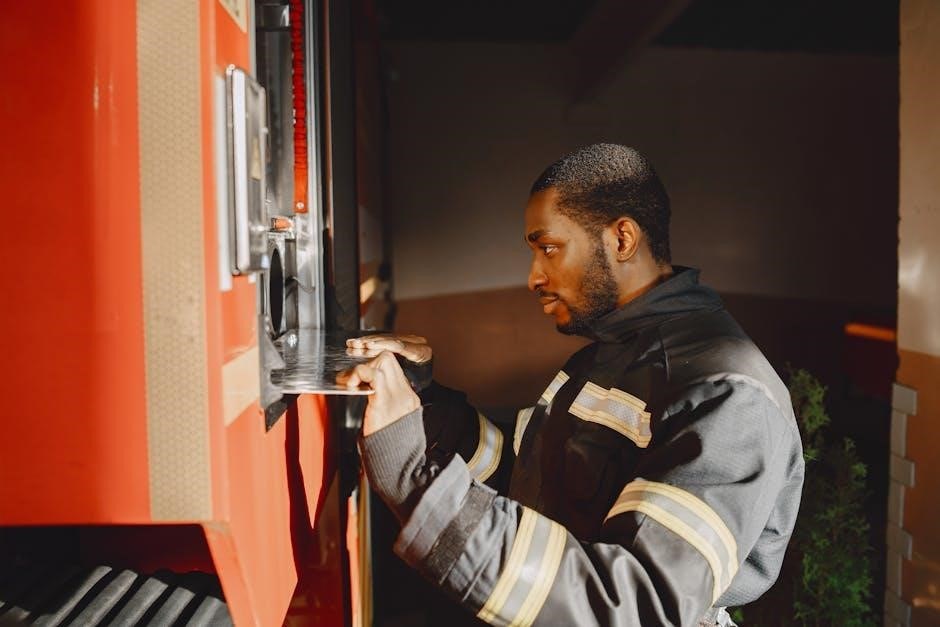Your First Alert Smoke Alarm is a vital safety device designed to detect smoke particles and alert you to potential fires. Ensuring proper installation, maintenance, and understanding of its features is crucial for optimal performance and safety. This guide provides comprehensive instructions to help you make the most of your smoke alarm, ensuring it functions correctly when needed most. Always follow the manufacturer’s guidelines and regulatory standards like UL217 for reliability and effectiveness in protecting your home and family.

Understanding First Alert Smoke Alarms
First Alert Smoke Alarms are designed to detect smoke particles from combustion, providing early warning of potential fires. They comply with UL217 standards and are engineered for reliability. Proper installation and maintenance ensure optimal performance and safety.
Types of Smoke Alarms
First Alert offers a variety of smoke alarms to meet different needs and preferences. The most common types include battery-powered and hardwired models. Battery-powered alarms are easy to install and provide flexibility, while hardwired alarms are more permanent and often preferred in new constructions. Additionally, there are smart smoke alarms that integrate with home automation systems, offering advanced features like voice alerts and remote notifications. Some models also combine smoke detection with carbon monoxide (CO) detection, providing dual protection. All types are designed to comply with safety standards, ensuring reliable performance. Choose the model that best fits your home’s requirements for enhanced safety and peace of mind.
How Smoke Alarms Detect Smoke
First Alert smoke alarms detect smoke by identifying particles of combustion in the air. These alarms are equipped with sensitive sensors that recognize even small amounts of smoke, triggering an alert to provide early warning of a potential fire. The detection process involves airflow entering the alarm, where smoke particles disrupt a light beam or ionization chamber, activating the sensor. This activation prompts the alarm to sound, ensuring you are alerted promptly. The technology is designed to respond to varying smoke conditions, from slow-burning fires to fast-spreading flames, offering reliable protection. Regular testing and maintenance, as outlined in the manual, are essential to ensure the alarm functions correctly when needed most. By understanding how smoke alarms detect smoke, you can trust their ability to keep your home and family safe from fire hazards.

Installation and Placement
First Alert smoke alarms detect smoke by identifying particles of combustion in the air. These alarms use sensitive sensors that recognize even small amounts of smoke, triggering an alert to provide early warning of a potential fire. The detection process involves airflow entering the alarm, where smoke particles disrupt a light beam or ionization chamber, activating the sensor. This activation prompts the alarm to sound, ensuring you are alerted promptly. The technology is designed to respond to varying smoke conditions, from slow-burning fires to fast-spreading flames, offering reliable protection. Regular testing and maintenance, as outlined in the manual, are essential to ensure the alarm functions correctly when needed most. By understanding how smoke alarms detect smoke, you can trust their ability to keep your home and family safe from fire hazards.
Choosing the Right Location
Proper placement of your First Alert Smoke Alarm is critical for reliable fire detection. Install alarms on every level of your home, inside each bedroom, and outside sleeping areas. Place them high on walls or on ceilings, as smoke rises. Avoid installing near windows, doors, or ducts, as drafts can interfere with detection. Keep alarms at least 10 feet away from cooking appliances to minimize false alarms caused by cooking smoke or steam. Do not install in areas with extreme temperatures, humidity, or dust, such as attics, garages, or bathrooms. Ensure alarms are in areas where smoke can reach them, avoiding dead-air spaces like corners. For larger homes, additional alarms may be needed to ensure full coverage. By strategically locating your smoke alarms, you enhance their ability to detect fires early and provide life-saving alerts. Always follow the manufacturer’s guidelines for optimal placement and performance.
Step-by-Step Installation Guide
Installing your First Alert Smoke Alarm is straightforward when following these steps. Begin by turning off the power at the circuit breaker if it’s a hardwired model. Remove the alarm from its packaging and ensure all components, such as screws and anchors, are included. For ceiling or wall installation, locate the appropriate spot based on the manufacturer’s guidelines. Use a drill to create pilot holes if necessary, then secure the mounting bracket with screws. Attach the alarm base to the bracket, ensuring it clicks firmly into place. If battery-powered, insert the recommended 9V battery, making sure it is securely connected. For hardwired models, connect the wires to the terminals, following the wiring diagram in the manual. Finally, test the alarm by pressing the test button to ensure it sounds correctly. Check for any error lights or sounds that may indicate improper installation. Refer to the manual for troubleshooting if issues arise.
Positioning in Different Rooms
Proper positioning of your First Alert Smoke Alarm is essential for maximizing its effectiveness. In bedrooms, place the alarm on the ceiling or high on a wall, at least 12 inches away from any corner. For kitchens, position the alarm away from cooking areas to minimize false alarms caused by smoke or steam. In living areas, install the alarm on the ceiling or wall, ensuring it is at least 12 inches away from any light fixtures. Basements require alarms to be placed near the bottom of the stairs or along the ceiling to ensure early detection. Avoid placing alarms near windows, doors, or ducts, as drafts may interfere with smoke detection. For larger rooms or open spaces, consider installing multiple alarms to ensure complete coverage. Always follow the manufacturer’s guidelines for optimal placement, and test the alarm periodically to ensure it is functioning correctly. Proper positioning ensures your First Alert Smoke Alarm provides reliable protection for your home and family.

Maintenance and Care
Regular maintenance ensures your First Alert Smoke Alarm operates effectively. Clean the alarm monthly using a vacuum to remove dust and debris. Test the alarm weekly by pressing the test button. Replace batteries annually or when a low-battery alert sounds. Avoid exposing the alarm to harsh chemicals or excessive moisture. Keep the alarm free from obstructions to ensure proper smoke detection. Regular upkeep helps maintain reliability and ensures your safety in case of an emergency.
Cleaning the Smoke Alarm
Cleaning your First Alert Smoke Alarm regularly is essential to ensure proper functionality. Dust, dirt, and debris can accumulate and interfere with the sensor, leading to false alarms or reduced sensitivity. To clean the alarm, start by turning it off and removing it from the ceiling or wall. Use a soft, dry cloth or a vacuum cleaner with a gentle suction setting to wipe away dust and particles from the exterior and interior surfaces. Avoid using damp cloths, chemicals, or abrasive materials, as they may damage the sensor or other components.
For more thorough cleaning, a small, dry brush can be used to gently sweep away debris from the alarm’s openings. After cleaning, reinstall the alarm and test it by pressing the test button to ensure it is working correctly. Regular cleaning helps maintain the alarm’s accuracy and reliability, providing peace of mind for your home’s safety; Perform this maintenance at least once a month or as needed, especially in areas prone to dust or smoke.
Testing the Alarm
Testing your First Alert Smoke Alarm is a critical step in ensuring it functions properly and provides reliable protection. The alarm should be tested weekly to confirm it is working correctly. Locate the test button, usually found on the front or side of the unit, and press it firmly. A loud, continuous beep should sound, indicating the alarm is operational. If the sound is weak or absent, it may indicate a problem, such as a low battery or a faulty sensor.
If the alarm does not sound during testing, check for obstructions or debris blocking the sensor. Clean the unit as described in the cleaning section and test it again. If issues persist, replace the battery or the entire unit if it is no longer under warranty. Regular testing ensures your smoke alarm is ready to alert you in case of an emergency, providing peace of mind for your home and family. Always follow the manufacturer’s guidelines for testing and maintenance to ensure optimal performance.
Battery Replacement
Replacing the battery in your First Alert Smoke Alarm is a simple process that ensures continuous protection. For battery-powered models, open the alarm by sliding it off the mounting bracket or twisting it counterclockwise. Locate the battery compartment, usually on the back or bottom of the unit. Gently pull out the old battery and discard it properly. Insert a new 9-volt battery, making sure it is securely connected and the terminals are facing the correct direction. Close the compartment and reattach the alarm to its bracket or base.
- Use only the recommended battery type (9-volt) for optimal performance.
- Avoid mixing old and new batteries or using rechargeable ones.
- If your alarm is hardwired, it may have a backup battery that also needs periodic replacement.
After replacing the battery, test the alarm to ensure it is functioning correctly. Replace batteries annually or when the low-battery chirp sounds. Proper battery maintenance ensures your smoke alarm remains reliable and ready to alert you in case of an emergency.

Troubleshooting Common Issues
If your First Alert Smoke Alarm is not functioning properly, check for common issues like dust buildup, expired batteries, or loose connections. Clean the alarm regularly and test it weekly. Refer to the user manual for specific solutions to error lights or unusual sounds. Proper maintenance ensures reliable performance and peace of mind.
Dealing with False Alarms
False alarms on your First Alert Smoke Alarm can be frustrating but are often caused by external factors. Common triggers include cooking smoke, steam from showers, or abnormal air conditions. To address this, avoid placing alarms near kitchens or bathrooms. Regular cleaning of the sensor chamber can reduce false alarms caused by dust or debris. If an alarm occurs, press the test/silence button to temporarily mute it. Ensure the alarm is installed at least 10 feet away from cooking appliances. If false alarms persist, consider relocating the alarm or replacing the battery. Never disconnect the battery or remove the alarm, as this compromises your safety. For recurring issues, refer to the user manual for troubleshooting specific to your model. Proper maintenance and placement are key to minimizing false alarms while ensuring reliable fire detection. Always follow the manufacturer’s guidelines to maintain your smoke alarm’s effectiveness and avoid unnecessary disruptions.
Understanding Error Lights
Your First Alert Smoke Alarm may display error lights to indicate specific issues. A flashing red light, for example, often signals a low battery or a malfunction. Refer to your user manual for model-specific light patterns, as they can vary. If the error light persists after addressing the issue, such as replacing the battery or cleaning the sensor, the alarm may need further attention. Some models also feature a yellow light to indicate the need for maintenance, like dust removal. Understanding these lights is crucial for ensuring your alarm operates correctly. Always consult the manual for precise troubleshooting steps, as different models may have unique indicators. If the problem remains unresolved, contact customer support or replace the unit if necessary. Regular monitoring of error lights helps maintain your smoke alarm’s reliability and ensures your safety. By addressing these signals promptly, you can prevent false alarms and guarantee optimal performance. Always prioritize resolving error lights to keep your home protected.
Common Problems
First Alert Smoke Alarms may occasionally encounter issues that affect their performance. One common problem is false alarms, often caused by cooking smoke, steam, or dust particles. To resolve this, clean the alarm regularly and ensure proper ventilation. Another issue is low battery warnings, indicated by intermittent beeps. Replace the battery promptly to restore functionality. Additionally, sensor malfunctions can occur due to dust buildup or damage. Cleaning the sensor or replacing the unit may be necessary. Some users report intermittent error lights, which can signal a range of problems, from connectivity issues in smart models to internal faults. Always refer to the user manual for specific troubleshooting steps. If problems persist, contact First Alert support or consider replacing the alarm. Regular maintenance, such as testing and cleaning, can help prevent many of these issues. Addressing these common problems ensures your smoke alarm remains reliable and provides consistent protection for your home and family.

Advanced Features

First Alert Smoke Alarms offer cutting-edge technology, including smart home integration and voice alerts, to enhance safety and convenience. Models like the P1210 integrate seamlessly with smart systems, providing real-time notifications and voice alerts during emergencies, ensuring greater awareness and faster response times for your family’s safety.
Smart Home Integration
First Alert Smoke Alarms now offer advanced smart home integration, enhancing your safety and convenience. Compatible models, such as the P1210, seamlessly connect with popular smart home systems like Google Home, allowing you to receive real-time notifications on your smartphone or tablet. This feature ensures you are alerted to potential threats even when you are not at home. Voice alerts, available in select models, provide clear and audible warnings, helping you identify the type of emergency and its location. Through the Google Home app, you can monitor your smoke alarms, check their status, and receive push notifications for low battery alerts or detected emergencies. This integration not only enhances your home’s safety but also simplifies management, enabling you to control and monitor multiple devices from a single platform. For setup instructions, visit the official First Alert website and follow the integration guide. This advanced feature adds an extra layer of protection and peace of mind to your home safety system.
Voice Alerts
Select First Alert Smoke Alarms now feature advanced voice alert technology, designed to enhance safety and clarity during emergencies. These alarms are programmed to verbally identify the type of hazard detected, such as “Fire” or “Carbon Monoxide,” and can specify the room or area where the threat is located. This feature provides clear communication, especially in situations where visibility is low due to smoke or darkness. Voice alerts are particularly beneficial for households with children, elderly members, or individuals who may need additional time to react. Compatible models, such as the P1210, integrate seamlessly with smart home systems, allowing voice notifications to be sent to your smartphone or tablet. This feature ensures you are informed of potential dangers even when you are not at home. For optimal performance, ensure your alarm is properly installed and configured according to the user manual. The voice alert function can also be customized in terms of volume and tone to suit your preferences. Always test this feature regularly to ensure it is functioning correctly.

Compatibility and Accessories

Your First Alert Smoke Alarm is designed to be compatible with various models, ensuring seamless integration with existing systems. Accessories like mounting brackets and additional sensors enhance functionality, while maintaining compliance with safety standards like UL217.

Compatible Models
First Alert Smoke Alarms are compatible with a range of models, ensuring seamless integration and enhanced safety. Popular models like the SA4120, P1210, and PR710/PR710B are designed to work together, offering comprehensive protection. These models are UL217 certified, meeting strict safety standards. The SA88TTCAUS is another compatible option, known for its reliability and advanced features. All BRK and First Alert Smoke Alarms are cross-compatible, allowing for a unified system in your home; This compatibility ensures that all units can communicate and provide consistent alerts during emergencies. Always check the user manual for specific compatibility details to ensure your system works harmoniously. Proper installation and maintenance of these models are crucial for optimal performance. By choosing compatible models, you can create a robust safety network tailored to your home’s needs.
Additional Accessories
To enhance the functionality and installation of your First Alert Smoke Alarm, several accessories are available. These include mounting hardware, adapter plugs, and remote controls, which simplify installation and customization. For hardwired models, the First Alert Smoke Alarm Adapter Plug ensures compatibility with existing wiring systems. Additionally, remote controls like the First Alert Remote Control allow you to test and silence alarms from a distance, providing convenience and ease of use.
Battery-powered models often come with optional locking features to prevent tampering, ensuring the alarm remains operational. Accessories like the First Alert Smoke Alarm Locking Pin can be purchased separately for added security. For smart home integration, compatible hubs or bridges may be required to connect your smoke alarm to your smart home system. Always refer to the user manual or manufacturer’s website for a list of recommended accessories tailored to your specific model. These accessories ensure your smoke alarm system is fully functional, secure, and integrated into your home’s safety network.
